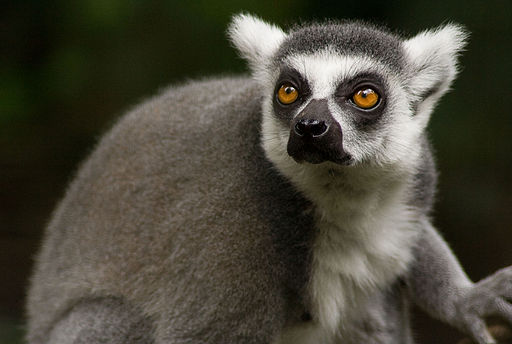Lemur Videos Fuel Demand for Pets
New research analysing social media reactions has found that viral videos of seemingly cuddly wild animals fuels the demand for the illegal pet trade and has harmful impacts on the animals themselves and their populations in the wild.
 Image: By Rvb (Own work) [Public domain], via Wikimedia Commons
Image: By Rvb (Own work) [Public domain], via Wikimedia Commons How many of us have laughed at cat or dog videos on social media? Their popularity shows no sign of waning, but other cute animals have begun to join them on the internet – think of tourist videos of someone snuggling a tiger cub, tickling a loris or feeding a sloth.
Now, a new study of Twitter activity shows that viral videos of seemingly cuddly exotic animals can have a dark side too – by fuelling demand for them as pets.
The study, published in PLoS ONE, focused on a 2016 viral video of a ring-tailed lemur demanding back scratches from two boys in a village in Madagascar. Each time the children take a break, the lemur turns toward them and points to a spot on its back as if begging for more.
Reactions on social media ranged from “so sweet” and “awwww-cute” to “freaking adorable.” The video quickly made the rounds on the internet, and within a week the original Facebook post had 20 million views.
Researchers downloaded and analysed nearly 14,000 tweets mentioning pet or captive lemurs over an 18-week period before and after this video appeared online. As the video was liked and shared, the volume of tweets saying things like “I want a pet lemur” and “where can I find one?” more than doubled.
Google and YouTube searches for the phrase “pet lemur” also spiked in the weeks after the video went viral, compared with other times between 2013 and 2018.
None of the tweets revealed anyone actually buying or selling lemurs on Twitter. But the researchers worry such incidents could encourage would-be wildlife traffickers, particularly in Madagascar, the only place where the endangered primates live in the wild.
Lead author Tara Clarke, who was a visiting assistant professor of evolutionary anthropology at Duke University at the time of the study, explains: “We know that virtually none of the people who tweet about wanting a pet lemur after seeing a viral video actually get one as a pet. But without context, the perceptions that people might get from these viral videos or photographs on social media could lead to indirect negative impacts on these animals in the wild.”
Pet lemurs are technically illegal in Madagascar. But the laws are difficult to enforce, especially in remote villages where law enforcement personnel may be few.
Previous research suggests that more than 28,000 lemurs have been illegally removed from the forest since 2010. Many of them are kept as pets in Madagascar’s hotels and restaurants, for well-intended tourists to cuddle or take selfies with. Pet lemurs in Madagascar experience a myriad of psychological and physical problems as a result of their capture. They are often kept alone in cages or on a short leash so do not have the ability to express natural behaviours such as socialisation and foraging. Their diet is often inadequate (when fed human foods such as rice that they do not eat in the wild) and this, combined with their unnatural environment, can lead to stress and the development of harmful stereotypical behaviours. Health problems such as obesity and diabetes are common.
The removal of such a vast number of individuals from the wild results in smaller populations with lower survivability. Small troops of lemurs suffer from a reduced foraging ability, and they are less able to defend themselves from predators and other troops, or care for juveniles. Alongside a loss of genetic diversity and reduced juvenile survival, this leads to the decline of wild populations.
More than 30 of the roughly 100 known lemur species are affected by the pet lemur trade, but the ring-tailed lemur – recognisable by its long black-and-white striped tail – was the species most people tweeted that they wanted as a pet.
Twenty years ago, the ring-tailed lemur population was estimated at more than 750,000, based on satellite images. No one knows how many ring-tailed lemurs live in the wild today – some estimates suggest there may be fewer than 5,000 left, others suggest as few as 2,000. This constitutes a 95% decline since the year 2000, and to put that number in context, there are now fewer ring-tailed lemurs living in the wild than there are living in zoos around the world.
This study isn’t the first to suggest that exotic animal selfies can harm wildlife. Previous research shows that photos of other animals such as chimpanzees or squirrel monkeys in contact with people can skew public perception of how endangered they are, and mislead people into thinking they make good pets. Selfies taken by celebrities are also ‘normalising’ the behaviour of interacting with wild or captive animals, resulting in many people trying to copy them – between 2014 and 2017, there was a 292% increase in the number of wildlife selfies posted on Instagram. About 40% of these were considered to be ‘bad selfies’ due to the type of interaction with the animal, for example, hugging, holding, touching or baiting.
A 2017 study looking specifically at kangaroos who are exposed to wildlife tours concluded that both wild and captive kangaroos can be stressed by humans approaching them closely. The presence of tourists may drive them away from feeding, breeding or resting areas, and it noted that the potential knock-on effects for kangaroo population numbers are still unknown.
Selfies with pet lemurs are proving to be popular as internet connectivity improves in Madagascar, the researchers say.
Conservation biologist Kim Reuter, a co-author on the study, said: “For many people in Madagascar, taking selfies with lemurs can signal social status. Although our study was limited to English-speaking Twitter users, we know how rapidly and powerfully social media can help spread information in developing countries like Madagascar. When some of this content goes viral, it could well lead to direct and indirect impacts on wild lemur populations.”
Clarke emphasises: “What we’re trying to get across is: Think twice before you click like, before you share.”




Sorry, comments are closed on this post